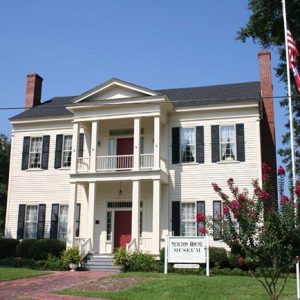calsfoundation@cals.org
Newton House Museum
The Newton House Museum in El Dorado (Union County) was the home of John and Penelope Newton, early settlers of Union County. It was placed on the National Register of Historic Places on November 6, 1974. For many years, the home was referred to as the Rainey-Newton House, due to a misconception that El Dorado city founder Matthew Rainey had built the home. However, extensive research by one of John Newton’s descendants proved that Rainey sold city property to the Newtons, but the Newtons were the actual builders of the house.
The Newton House was built circa 1849 in the Greek Revival style popular in the antebellum era. The house features many characteristics of Greek Revival vernacular architecture, including simplified Doric columns at the entrance and side porch. Many of the doors on the house are original and feature tenon and mortise construction methods. The interior door frames feature Victorian rosettes on the molding.
It is believed that the Newtons built the house in El Dorado so that their young children could attend the schools in town; their plantation was actually several miles northeast of El Dorado. The house remained in the Newton family until John and Penelope Newton’s daughter, Mary Alabama Wright, sold it in 1898. Originally, the house had faced south on Peach Street with a clear view of El Dorado’s downtown commercial district, but it was moved to its present location on Jackson Street in 1910.
By the 1970s, the house was falling into disrepair, and a movement began in El Dorado to save the home for posterity. The nonprofit South Arkansas Historical Foundation (now the South Arkansas Historical Preservation Society) purchased the home in 1978 and began the restoration process. With grants and local fundraising, combined with the input and help of local citizens, the house was restored to its former glory.
Additional restoration work continued into the next two decades, and the house opened as a museum containing period furnishings and artwork, including an oil portrait of Penelope Newton. Interesting furnishings on display include a melodeon, linen press, “mammy bench,” and Yo-Yo quilt. The dining room has a rare oil portrait of Congressman Albert Rust, an important early political figure in southern Arkansas history. The grounds feature seasonal flowerbeds and mayhaw trees. The Newton House Museum is operated by the South Arkansas Historical Preservation Society.
The museum is known in the community for its special events and educational programs, including its annual Mayhaw Festival, held on the grounds of the Newton House the first Saturday in May. The street festival features house tours, vendors, and the sale of a beloved regional delicacy—mayhaw jelly—made by the society’s volunteers.
The Newton House Museum is open to the public for tours year round, hosts programs throughout the year, and is available for special events.
For additional information:
Beavert, Marjana N. “Brief History of the Rainey-Newton Home.” Brochure published by the South Arkansas Historic Preservation Society.
“The Historic John Newton House (1849–1999).” Brochure published by the South Arkansas Historic Preservation Society.
“Matthew Rainey House (John Newton House).” National Register of Historic Places nomination form. On file at Arkansas Historic Preservation Program, Little Rock, Arkansas. Online at http://www.arkansaspreservation.com/National-Register-Listings/PDF/UN0105.nr.pdf (accessed November 23, 2020).
Newton House Museum. http://soarkhistory.com/Newton-House-Museum.html (accessed November 23, 2020).
Stiles, Wilson. “Historic Structures Report, John Newton House, ca. 1850, El Dorado, Arkansas.” N.p.: 1979.
Patrick Hotard
Newton House Museum
 Historic Preservation
Historic Preservation Louisiana Purchase through Early Statehood, 1803 through 1860
Louisiana Purchase through Early Statehood, 1803 through 1860 Museums
Museums Newton House Museum
Newton House Museum  Newton House
Newton House 




Comments
No comments on this entry yet.